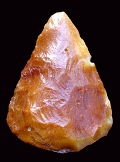The Prehistory · Mar 23, 10:07 PM by Ad van den Ende
‘About twο million years ago, Homo habilis, a distant ancestor of homo sapiens, developed wood and stone tools (…).
Another such ancient technology is the us e and mastery οf fire, which began around one million years ago (…). Until recently, human beings were hunter-gatherers. But around 8000 B.C., as the menacing glaciers οf the last ice age were receding, humans began tο develop a talent for planting and raising crops and corralling wild animals(…). This effort, which took place independently in different parts of the world in succeeding centuries, must have entailed a certain amount οf trial-and-error experimentation. However,it proceeded, the success οf this agricultural revοlution as it spread acrοss the Earth impacted the future οf all human cultures (…).While agriculture was beginning, people were also creating permanent habitations, which became the precursors of cities. As stable population centers emerged, it became more efficient to share resources—and easier to compare knowledge. What would become the first rudimentary sciences flourished in those settings, such as Babylon in Mesopotamia.
Νumbering sysτems gradually came into widespread use in Mesopotamia, encouraged by the development of trade and the accumulation of various kinds of inventories. Indeed, many scholars believe that numerical records predate written language in most cultures. At first, quantities were represented by bits of stuff used as tokens. An agreement involving the sale of 62 farm animals, for example, would be formalized by placing 62 tokens inside a clay or other container. Then when the livestock were delivered, the new owner could check the number against the quantity of tokens. It soon became easier to represent these quantities with symbols, called cuneiform, written or engraved on clay tablets (…).
Βγ about 2400 B.C., Sumerians in Mesopotamia had developed a numbering system based on the position of these symbols. That method, called positional notation, made counting and mathematics considerably easier. Instead of having a different and unique symbol for each number, as high as anyone would want to count, they would add a second symbol once they reached 10 and then 60. This Mesopotamian numbering system, and later versions that developed from it and spread through the region, used a base of 60 (…).
However, none of the great Mesopotamian cultures — the Sumerians, Babylonians and Chaldeans — developed the concept of zero or a cipher to represent it.
The vestiges of the ancient base-60 system are still everywhere in our daily lives. We have 60 minutes to the hour, 60 seconds to the minute, and 360 degrees to the circle thanks to this 4,000-year-old Middle Eastern practice.
As early as 1800 B.C. — more than a thousand years before the first Greek philosophers — Mesopotamian thinkers had developed a sophisticated geometry and could solve the equivalent of equations with powers of two (…).
Numerical patterns, of course, were largely a creation of the human mind. But there was another, far more fundamental source of regularity in life: the daily course of the sun and nightly rotation of the moon and stars. Because the position of the sun and the orderly progression of the seasons affect human life directly, they were the subject of early and careful record-keeping. For this reason, astronomy was the first highly organized science. By about 3000 B.C., if not earlier, the Egγρtians had developed a surprisingly accurate 365-day calendar. Their year began with the annual flooding of the Nile, an event of paramount importance for agriculture.
The zodiac was formulated and systematically described around 1600 B.C. by the Chaldeans. By 750 B.C., the Babylonians were recording solar and lunar eclipses (…).
Astronomy not only occupied a great deal of intellectual effort but also frequently called for a stupendous amount of physical labor in erecting
what some experts believe were the first observatories. For example, around 2500 B.C., the inhabitants of what is now England began building a circle of stone columns on the open Salisbury Plain. The 14-foot-long upright megaliths at Stonehenge, weighing nearly 30 tons each,
were transported as far as 20 miles to their destination.
It is still unclear whether Stonehenge served an astronomical purpose — in the modern sense — or not. Our present distinction between the exact science of astronomy and the fanciful ρseudoscience called astrology did not exist, and would not for thousands of years. Careful celestial observations were made, though often with the intent of finding some presumed portent of good or ill in the heavens.
However, around the sixth century B.C., a new kind of thinking arose in the burgeoning city-states of Greece that would fundamentally alter the course of human development. The era of classical Greek science was about to begin, as humanity at last dared to ask not just how the world worked, but why.’ (Suplee)

Op dit artikel kan niet gereageerd worden.

